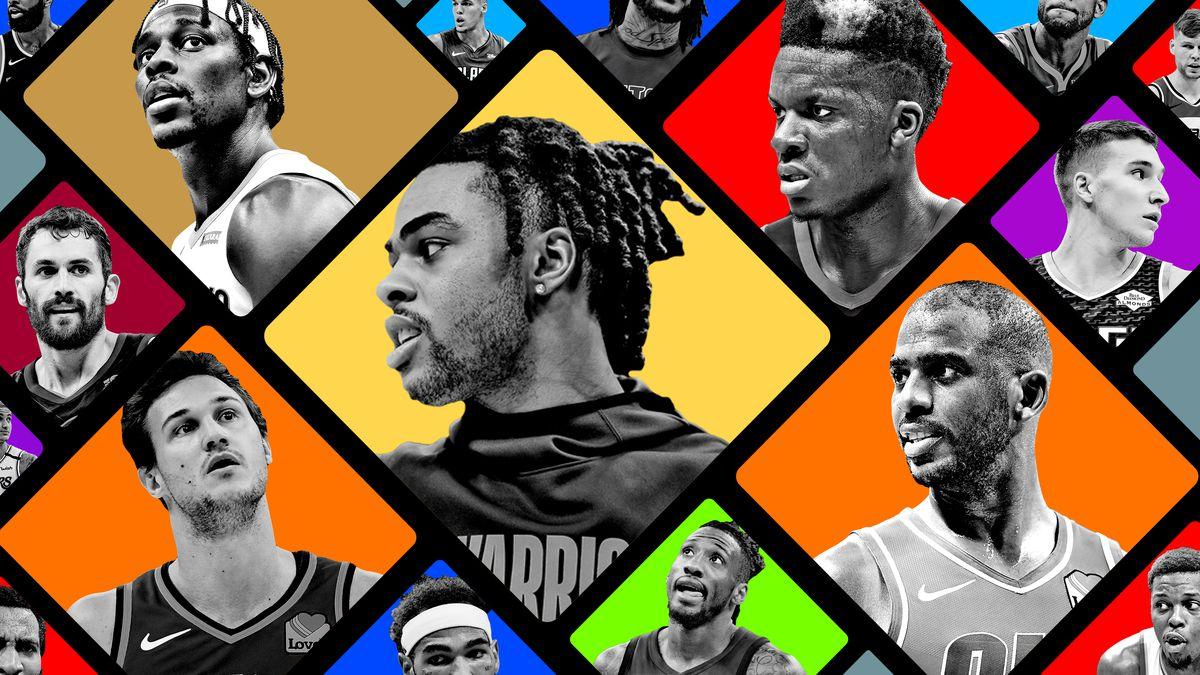
The Grizzlies jumped the line in the West’s pecking order this season. The franchise just began a rebuilding project led by a new front office and a new head coach. The team wasn’t supposed to be competing for a playoff spot, much less having as many wins as the no. 8 seed at midseason, ahead of teams who have spent years trying and failing to break into the postseason.
Memphis’s turnaround began this summer, when new vice president of basketball operations Zachary Kleiman quietly assembled one of the best young cores in the NBA. Everyone knew about the potential of Jaren Jackson Jr., the no. 4 pick in the 2018 draft, and Ja Morant, the no. 2 pick in 2019. But no one saw the Grizzlies’ other two key pieces coming. Brandon Clarke was the no. 21 pick in what was considered a weak draft this past summer. And De’Anthony Melton was a former second-round pick sent to Memphis as a throw-in from the Suns. Despite Morant and Jackson Jr. receiving most of the praise for this year’s 20-24 start, there would be no surprise playoff push in Memphis had all four not played at a high level.
Clarke and Melton were the statistical darlings of their respective drafts, and analytical models rated both of them highly. There were four important things the two had in common: They were efficient offensive players, they had high steal rates, they had high block rates, and their NCAA teams (Gonzaga for Clarke, USC for Melton) always performed better when they were on the floor.
But most NBA teams weren’t sold on them because they lacked a clear position at the next level. Melton was trapped between the 1 and the 2. He didn’t rack up assists like a point guard or have the size and shooting ability of a shooting guard. (His draft stock was also hurt because he sat out his last season of college basketball due to his involvement in a bribery scandal). Clarke was trapped between the 4 and the 5, without the offensive skill set of a power forward or the size of a center.
The key for the Grizzlies was focusing on what the two could do well and not on what they couldn’t. They plugged Melton and Clarke into an up-tempo system that gave them the freedom to make decisions on offense and required them to hold their own against bigger players on defense. Memphis used advanced metrics to identify the two young players whose skills were undervalued by the rest of the league. It was essentially the NBA’s version of Moneyball, almost 20 years since the baseball phenomenon.
The Grizz began winning almost as soon as Melton entered the rotation in early December. His modest per-game averages—7.9 points on 45.4 percent shooting, 3.9 rebounds, 3.0 assists, and 1.3 steals in 17.6 minutes—don’t tell the whole story of his impact. Melton doesn’t play much, but he takes over games when he does. He’s a plus-minus machine, with a bigger impact on his team’s performance than some of the biggest stars in the league:
De’Anthony Melton’s Impact
It helps that the Grizzlies have significantly less talent than the rest of the teams on that list, since Melton is boosting his team from a much lower point than any of the other players.
But there is still something profound happening when he checks in. Melton isn’t dominating by scoring a lot of points. He’s doing a lot of subtle things on both ends of the floor—guarding the opposing team’s best scorer, disrupting the flow of their offense, and then moving the ball and finding the open man when the Grizzlies are on offense. Melton is an incredibly smart player who seems to always be thinking one step ahead of everyone else.
The Grizzlies are playing him on the wing even though he lacks ideal size (6-foot-2 and 200 pounds) and athleticism for the position. He makes up for it with his long arms (6-foot-9 wingspan) and quick hands as well as an intuition of when to use them. Melton is built like an NFL defensive back and he plays like one on the court. Making a pass is never safe with the Grizzlies’ shutdown corner in the area:
The numbers back up the tape. Melton is tied for the fourth-highest steal percentage in the NBA this season (3.6) and he’s in the top 10 in block percentage (1.7) among players 6-foot-3 and under.
The second-year guard isn’t the same dominant force on offense, but he still finds ways to help his team. While he’s not a great outside shooter (30.5 percent from 3 on 1.8 attempts per game), he’s a high-IQ player who rarely takes bad shots and averages twice as many assists (3.0) per game as turnovers (1.5).
Memphis primarily plays him in small backcourts next to either Morant or backup point guard Tyus Jones. Melton’s value derives from his ability to succeed in those lineups. The Grizzlies get all the benefits of playing two point guards on offense without the typical downsides on defense. Melton’s net rating goes from plus-18.0 in 245 minutes with Jones and plus-10.8 in 158 minutes with Morant to minus-1.2 in 161 minutes without either.
But his best partner in crime has been Clarke, who has played more minutes with Melton (305) than anyone else on the team. He’s just as big of a statistical anomaly. He currently has the highest field goal percentage (62.9) of any NBA rookie in history to average at least 10 points per game.
It starts with Clarke’s freakish athleticism. At 6-foot-8 and 215 pounds, the forward can run with any guard in the league and dunk over any big man. And he doesn’t just get up once. He’s so quick off the ground that he can jump again while his opponents are still coming down the first time.
Like Melton, Clarke knows how to use his physical tools. He plays with the savvy of someone a decade older. It’s easy to see where his efficiency comes from. Nobody can stop him from getting to his preferred spots on the court, and he doesn’t take shots from anywhere else. He came into the league with an already advanced floater, which he can get off against almost any defender:
That combination of athleticism and intelligence has proved just as valuable on defense. Clarke has the inverse statistical profile of Melton, with an elite block percentage (3.5) and a high steal percentage (0.9) for a player his size.
Playing two elite defenders who can also score in transition is rocket fuel for a Grizzlies team that already likes to play fast. Memphis boasts the third-quickest pace in the league this season, and runs even faster when its two spark plugs come in.
Melton and Clarke boost their team’s possession count in two ways. They generate extra possessions on defense by creating turnovers, and they add to their value on offense by taking care of the ball and attempting only high-percentage shots. Stacking those possessions together can blow open a game quickly. Look at this 30-second stretch from a game against the Spurs two weeks ago. Melton grabs a defensive rebound and finds a streaking Clarke for a dunk in transition. Clarke then returns the favor the next time down the floor, starting a fast break and finding Melton for an open 3:
These two are doing exactly what you would expect when you look at their college performances. Clarke had an eye-popping stat line at Gonzaga last season: 16.9 points on 68.7 percent shooting, 8.6 rebounds, 3.2 blocks, and 1.2 steals per game. Melton was one of the best defenders in the country in his last season at USC, averaging 1.9 steals and 1.0 blocks per game.
That is where the Moneyball comparison comes in. The Grizzlies trusted the numbers much like Billy Beane trusted his, and they put Melton and Clarke in positions where they normally wouldn’t fit. But their success isn’t really about computer models trumping older ways of thinking about the game anymore than the original Moneyball was.
Players like Melton and Clarke actually bridge the gap between those two worlds. They consistently make the types of plays—the correct rotation on defense, the extra pass on offense—that coaches love but that don’t show up in the box score. The rise of advanced statistics has just made it easier to appreciate what they do than it was a generation ago.
The funny thing is that there is nothing all that “advanced” about statistics like net rating. You don’t need to be a mathematician. All you have to do is count every basket scored when a player is in the game. Coaches do that naturally because they are already watching every possession with laser focus. Net rating just gives everyone else easy access to the same information.
Even as analytics become more mainstream, Clarke and Melton will never get as much credit as Morant and Jackson, former lottery picks who are the faces of the organization. Those two are great young players in their own right. But it’s hard for two 20-year-olds to drive a winning team on their own. The Grizzlies have a net rating of minus-1.0 with Morant on the floor this season and minus-3.4 with Jackson.
The team’s ultra-quick rebuild has been an overall effort. Franchise cornerstones and smart coaches are scattered throughout the bottom of the West. The reason that Memphis jumped the line to get back into the playoff picture after turning the page on the Grit and Grind era is their new front office’s ability to identify players like Melton and Clarke. There is plenty of free money lying on the ground in the draft. The Grizzlies picked it up.
Stats current through Tuesday’s games. Standings current through Wednesday’s games.


